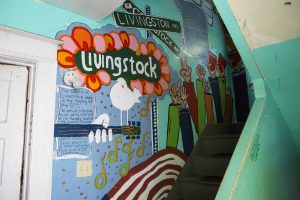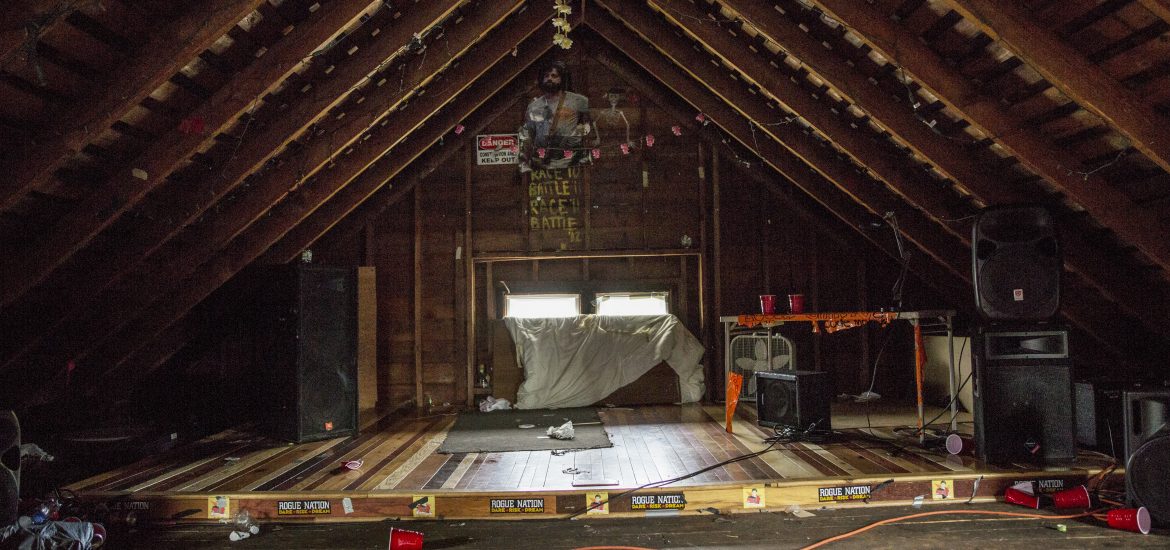701-703 Livingston Ave.
Fact: This house on the corner of Livingston Ave. features murals of “Livingstock,” a student organized block party inspired by Woodstock, celebrating the end of the school year from the late 60’s until 1999.
Illustrated through murals in the back stairwell of 701-703 Livingston Ave., the story of “Livingstock” is told. To most SU students today, the celebration is unheard of, though its history is nothing short of legendary. From Livingston to Clarendon, students would open up their lawns for a day of partying and music to celebrate the end of the academic year. Based on the idea of Woodstock, Livingstock revolved around good vibes and even better music, as live bands played in the front yard of 137 Clarendon St. for all to enjoy. The celebration was tradition for approximately three decades until it was banned in 1999.
According to the recollection of former student and current landlord Ben Tupper, the 1999 Livingstock was organized chaos. What started out as innocent partying soon turned to madness when groups of drunken students began throwing their furniture and trash into piles on the street. It wasn’t long before someone set fire to the mass and students began to chant and scream. When fire trucks approached, students quickly formed a human barricade so that the fire could not be put out. They even began throwing bottles and trash at oncoming firefighters in what seemed like a real-life Project X. The fire department began to blast water upward in an arch over the students, who rejoiced at the onset of “rain” and their own rebellion. The fire was eventually put out with the help of the Syracuse Police Department whose officers arrived on the scene in several rows, decked out in riot gear. According to Tupper, cops chased some students down as far as Westcott Street to disperse the crowd. After “Livingstock” was banned by the city of Syracuse that year, other attempts at hosting the festival-esque celebration were made, including “Euclidfest.” These efforts, however, were stopped by the city and replaced by the University’s creation of Mayfest, the end-of-the-year celebration where students are under the complete control and supervision of University faculty. Rumor has it that “Fuck Mayfest” T-shirts were quite a popular amenity during its first year.

516 Euclid Ave
Fact: “Casa Roja,” as it is sometimes referred to, has a legendary reputation for live music and partying that spans almost 30 years.
In 1989, Ben Tupper was living in the big red house at 516 Euclid Ave. The house was spacious with multiple levels including a large attic and second floor porch. According to his recollection, one weekend some of his housemates decided it would be fun to host a party at their home. A friend of theirs, who went by DJ 2000 Watts, would spin electronic music on the first floor while the attic would host a live band, creating the perfect setup for a house party unparalleled today. The party was a hit and not long afterwards, the housemates came to understand that they had tapped into something special within the University’s party scene. They began to run their parties like a business, collecting a $2 entrance fee at the door from all partygoers. The parties became so frequent and so well known that proceeds became substantial enough to pay the house rent. 516 gained a reputation as the go-to party/music spot year-round. The tradition didn’t end in 1989 either; every new tenant leasing the house wanted to create the same great experience as the year before. It became an unspoken obligation to continue the tradition.
Similar to the story of Livingstock, the history of 516 is told by murals in the stairwell of the house. The murals begin on the first level and continue up to the attic with more and more “historic” stories illustrated as the legacy continues.
438 Columbus Ave
Fact: This three-story house completed in 1900 was home to Gustav Stickley, a famous woodworker and furniture designer who would become one of the leading figures of the American Arts & Crafts movement.
Born on March 9, 1858, Gustav Stickley was one of eleven children in his family. They lived on a small farm in Wisconsin. By early 1876, Stickley’s mother and siblings moved to Brandt, Pa., where Gustav worked in his uncle’s chair factory – his first formal training in the furniture industry. In 1883, he and his brothers Charles and Albert formed the Stickley Brothers & Company, their first attempt at their own furniture company. However, the business dissolved in five years. By 1898, however, he formed the Gustav Stickley Company and began to create his first arts and crafts works in an experimental line called the New Furniture. This line offered progressive furniture designs for middle class consumers in white oak and other mostly native woods. Stickley’s first furniture, that is now categorized under the Arts and Crafts Movement, was introduced at the Grand Rapids Furniture Exposition.
With business beginning to boom, Stickley and his family moved into 438 Columbus Ave. On the outside, the house appears similar to many other houses on the block that cover a hillside leading up to Syracuse University. However, the interior that Stickley designed for it is regarded as the first instance of the design style that became known as American Craftsman. On December 24, 1901, when a fire damaged the house, Stickley himself renovated the interior. Stickley lived with his daughter Barbara Wiles and her family at this house from 1919 until his death in 1942. After his death, the house was sold to multiple owners until it was finally purchased by the Gustav Stickley House Foundation in 2015. The Gustav Stickley House Restoration Project was awarded a $10,800 grant through the Preserve NY Grant Program of the Preservation League of NYS. The Grant was awarded to the University Neighborhood Preservation Association which is leading Phase One Restoration of the house that commended this past August in 2017.

112 Avondale Place
Fact: This off campus residence became a crime scene in 2005 when a SU student disposed of his girlfriend’s remains on the side of the house after committing a violent murder.
Brian T. Shaw was a great example of student success, perseverance and hard work. He grew up in low-income neighborhoods in New York City and the southside of Syracuse. Shaw had dreams of becoming an obstetrician and was the first in his family to attend college. He attended Syracuse University, rushed a fraternity, and even joined the SU Cheerleading team. He likely would have gone on to achieve great success if it were not for the events that occurred on March 23, 2005, when he strangled and killed his girlfriend Chiarra Seals.
Seals’ disappearance was at first confusing for the police. Her apartment had been found with the door kicked in and nothing missing but Seals herself. The next morning her body was found with the garbage cans on the side of a house at 112 Avondale Ave, neatly packed into a large suitcase. During the course of the investigation, police contacted Shaw who at first denied any role in her disappearance and murder, but soon confessed to strangling Seals and disposing of her remains. The autopsy concluded that the cause of death was indeed strangulation by a rope or cord. She suffered from cuts and bruises as well. There was no connection between the murder and the Avondale Place home, but for whatever reason, it was the place Shaw chose to dump the body.
426 Ostrom Ave
Fact: Now the Department of Psychology Research Facility, this property once housed Air Crew Men during World War II.
An SU professor, Wellesley Perry Coddington, built this corner residence in 1875. The original space featured three stories of red brick, a winding staircase and oak trim throughout. Delta Upsilon Fraternity purchased this house in 1887 and they resided until 1972. During World War II however, brothers of DU moved out to make room for Army Air Crew men arriving on campus. Virtually all of the original structure was demolished during construction in 1955, aside from the main entrance and fireplace. Today, the DU letters can still be seen on the exterior of the house, just above the entrance.

